 |
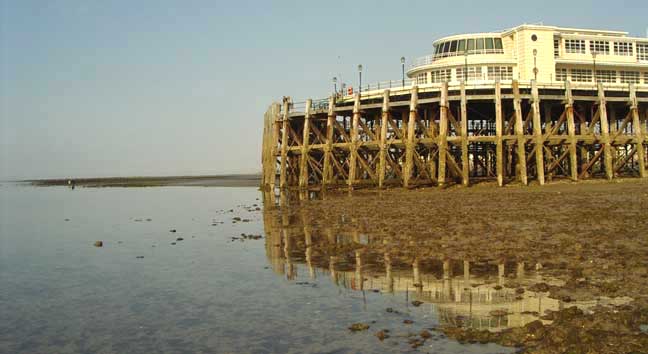 |
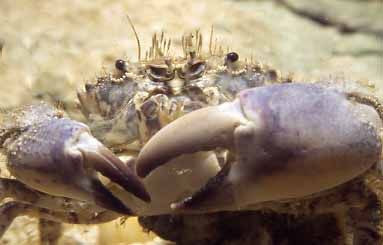 |
Lancing Beach
Ostensibly
a sand and shingle beach, but the sea bed uncovered by the low spring tides
in places has a hard bedrock and loose rocks. Surprisingly, some of the
less common crabs have been discovered between the tides and two species
of sea anemones reach their eastern limit up the English Channel at Lancing.
One other small species of sea anemone Diadumene
cincta is recorded here and only a few
other places around Britain. Offshore it is a breeding area of the small
orange fish known as Montagu's Sea Snail,
Liparis
montagui.
 |
 |
 |
Worthing Pier
The
rock and sand terrain beneath the amusement pier; at first glance, the
shore appears exclusively sandy and in all respects one of the least
promising of rockpooling shores. Firm sand leads
the explorer out to below mid-tide region where the sand gives away to
a mixed ground with rocks buried in the sand, a few looser rocks (cobble-sized),
and shallow sandy pools. Under the steel girders
of the pier is the best area, with the supports providing attachment points
of a sizeable
mussel community.
Worthing
Pier
Worthing
Pier on flickr
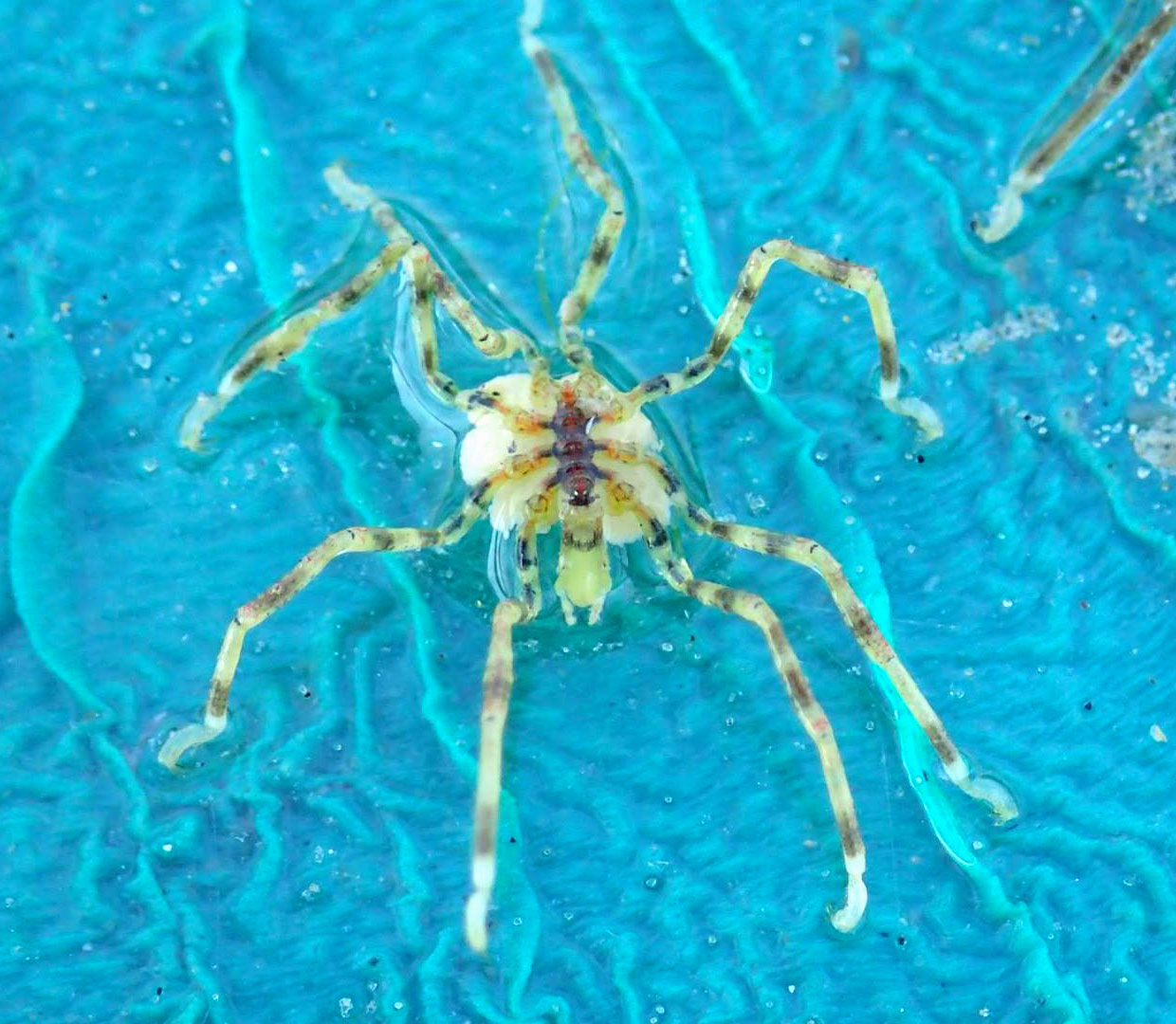 |
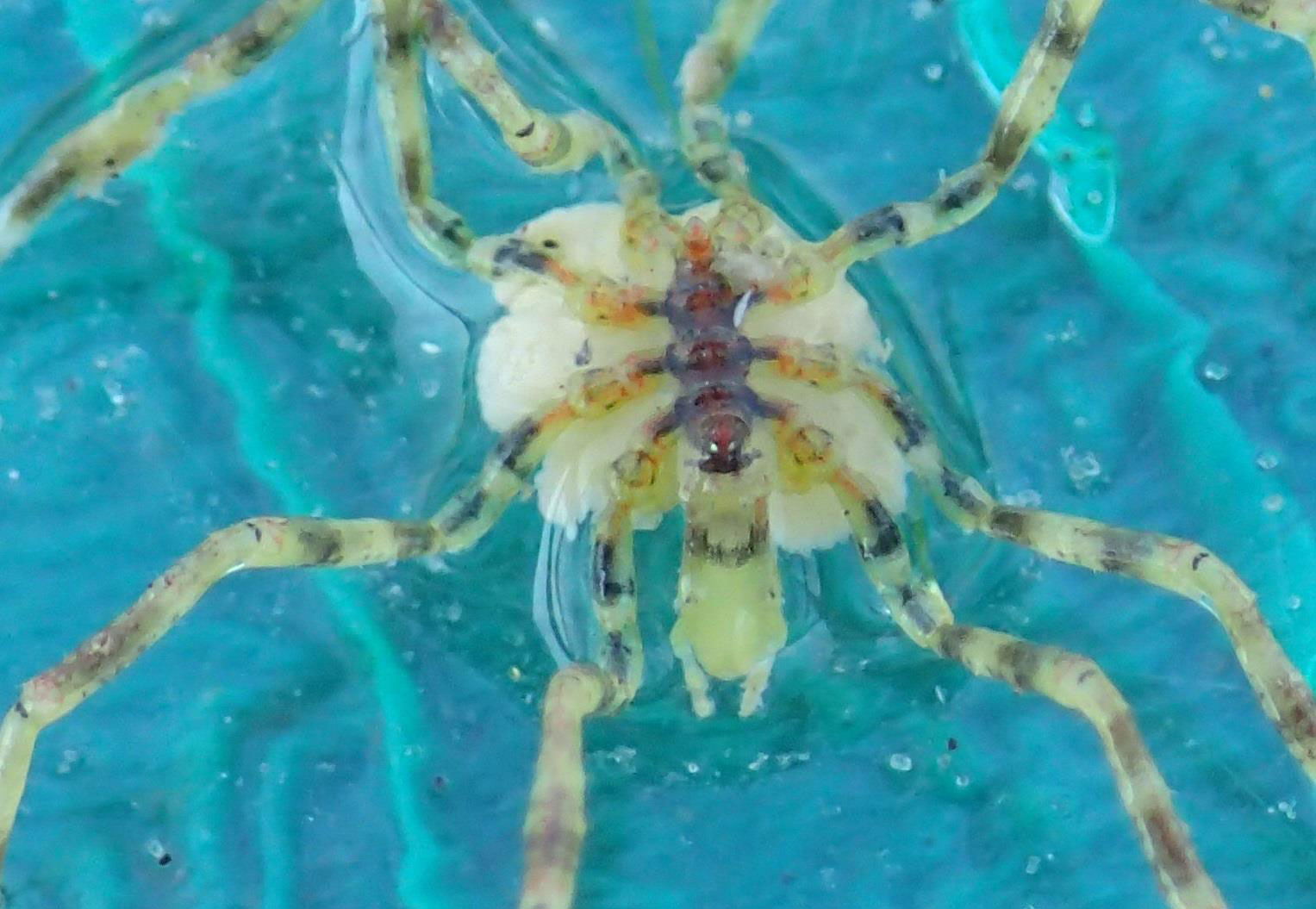 |
Sea
Spider
Ammothia
hilgendorfi
Photographs
by Keith Alexander
An almost unprecedented discovery of a strange sea spider on Worthing Beach was an extraordinary surprise. It looks nothing like the native pycnogonids! This means it was probably an alien species and almost certainly Ammothia hilgendorfi which was discovered once before in 1978 in Southampton Water. This specimen contained eggs. It originates in the tropical and temperate North Pacific littoral zone of south-east Asia.
20166 June 2016
Sepiola
Little
Cuttle
Shallow
seas of Widewater
5 June 2016
A trip to Worthing Pier on a low spring tide was very disappointing. Occasional Sagartia troglodytes sea anemones, and three Snakelocks Anemones, Anemonia viridis, and a dozen or so small Edible Crabs, Cancer pagurus, the same number of small Hairy Crabs, Pilumnus hirtellus, a few large Shore Crabs Carcinus meanas and the inevitable tiny Long-clawed Porcelain Crabs, Pisidia longicornis, was about the only fauna. Two very small nudibranchs Facelina auriculata were spotted on sea mat bryozoans. A bunch of Squid eggs washed up against the pier supports.
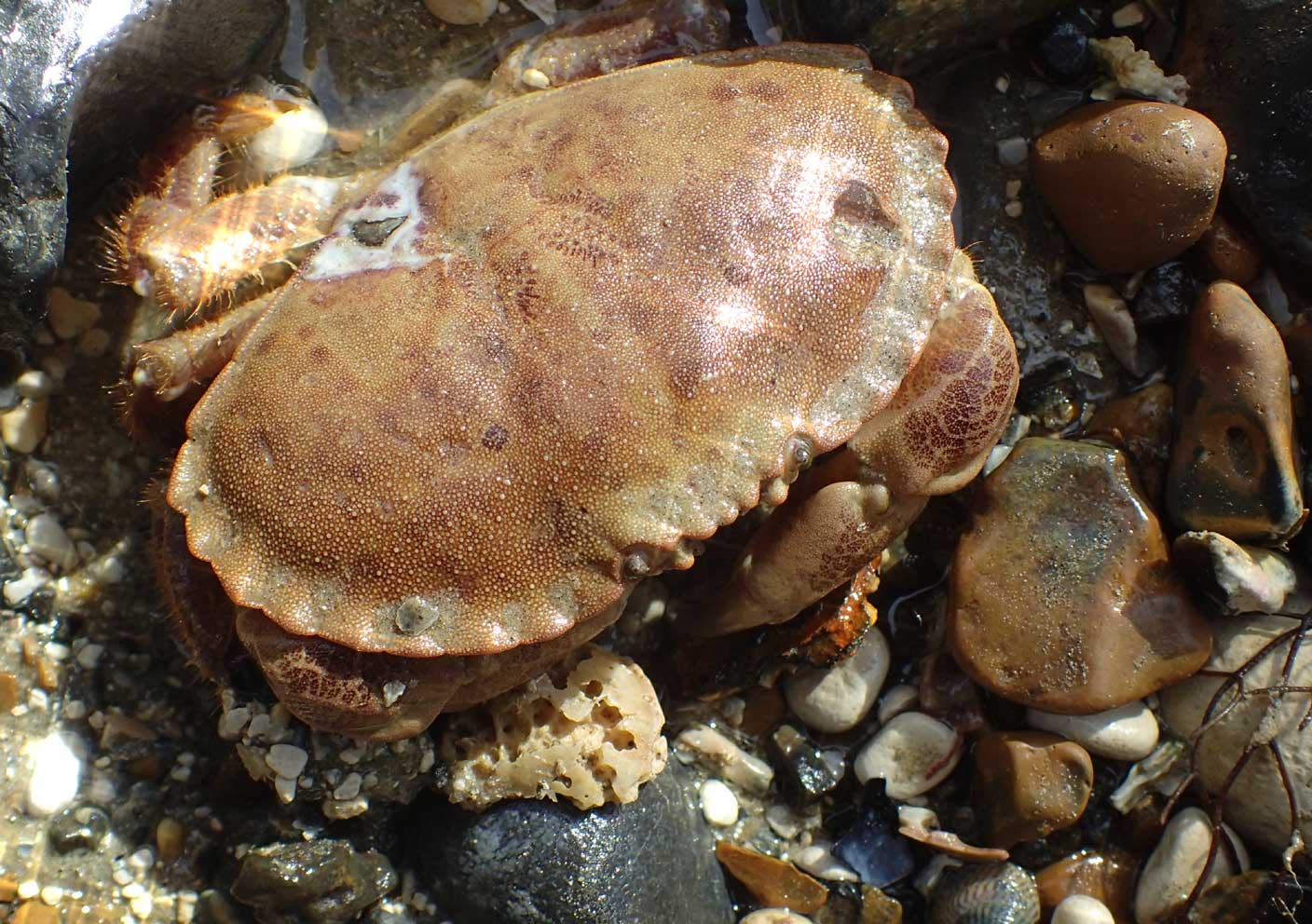 5
May 2016
5
May 2016
A
trip to Worthing Pier on a low spring tide was
so disappointing not to be newsworthy. There were three small Blennies,
Lipophrys
pholis, a few small Edible
Crabs,
Cancer
pagurus, a Velvet
Swimming Crabs,
Necora
puber, frequent Beadlet
Anemones,
Actinia
equina, occasional but small and inconspicuous
Sagartia
troglodytes, and two Snakelocks
Anemones,
Anemonia
viridis. A small flock of Turnstones
foraged amongst the rocks and bedrock. Two Sting
Winkles, Ocenebra erinacea, one
tiny one, was the most interesting find.
4 June
2015
Low
tide
in Worthing was early, around 6:00 am BST
(according to the Tide Tables although the
tide seemed low at 7:00 am).
The fauna was dominated by true crabs (Brachyura)
to the exclusion of almost everything else, with scores of small Velvet
Swimming Crabs,
Necora
puber, a handful of Shore
Crabs Carcinus
meanas including two females "in berry",
just two small Edible Crabs,
Cancer
pagurus, a tiny Long-legged
Spider Crab Macropodia rostrata,
and a sandy coloured Vernal Crab, Liocarcinus
vernalis found under a rock.
 |
 |
 |
 |
|
|
|
|
|
The inevitable tiny Long-clawed Porcelain Crabs, Pisidia longicornis, and slightly larger Hairy Porcelain Crabs Porcellana platycheles clung on the underside of boulders as expected. There was one Snakelocks Anemone, Anemonia viridis, a few Beadlet Anemones, Actinia equina, and occasional small and inconspicuous Sagartia troglodytes. Two very small 15 mm 5-Bearded Rockling, Ciliata mustela, were just past the "mackerel midge" stage when they change colour from silver to brown and start a benthic existence.
18
March 2015
The
tide
receded to end of Worthing Pier
and a small flock of Turnstones
probed amongst the rocks.
The intertidal fauna was unexceptional with nothing of note.
22 January 2015

Barrel
Jellyfish, Rhizostoma octopus
Photograph
by Margaret
Burton
Two large Barrel Jellyfish, Rhizostoma octopus, were discovered washed up on the shore at Lancing.
 |
 |
 |
 |
|
|
|
|
|
On a warm afternoon the low spring tide receded a long way on a calm day. The tide seemed to turn too quickly to examine the micro-invertebrate fauna on the underside of rocks, including several species of sea squirts, bryozoans, sea anemones, keelworms and acorn barnacles etc. Workmen were undertaking noisy repairs on the pier, so it was unpleasant to stay around for long and some of the best rocks could not be turned. Immediately, the first of half a dozen large Velvet Swimming Crabs, Necora puber, scampered sideways in the shallow water where a large amount of weed had become snagged on the pier supports and wound around the weed was a couple of Mermaid's Purses, and one contained a live embryo of a baby Lesser Spotted Dogfish Scyliorhinus canicula. The baby shark was released from its Mermaid's Purse and placed in a small aquarium. Other first year fish included juvenile Blennies, Lipophrys pholis, and Rock Gobies Gobius paganellus. In the shallower sandy pools nearer the shore there were hundreds of small Common Gobies, Pomatoschistus microps. The usual species of crabs were present including frequent Edible Crabs, Cancer pagurus, just one large Hairy Crab, Pilumnus hirtellus, a few large Shore Crabs Carcinus meanas and the inevitable tiny Long-clawed Porcelain Crabs, Pisidia longicornis, and slightly larger Hairy Porcelain Crabs Porcellana platycheles clinging on the underside of boulders as expected. One small Common Hermit Crab, Pagurus bernhardus, occupied a small winkle shell. However, the exceptional number in excess of thirty Long-legged Spider Crabs Macropodia rostrata, hiding under rocks was unprecedented from this shore. There were a few small Squat Lobster, Galathea squamifera, under rocks. Anemones were under represented compared to good times, with frequent Beadlet Anemones, Actinia equina, frequent but small and inconspicuous Sagartia troglodytes, occasional Daisy Anemones Cereus pedunculatus, and two Snakelocks Anemones, Anemonia viridis, Small prawns inhabited the small pools of water as expected.
A
Clouded
Yellow Butterfly flew over the shingle
of east Worthing beach by Brooklands.
19
May 2014
Shoreham
beach was in bloom. Of most notice were the large amounts of Red
Valerian, flowering
Sea Kale, swathes of Sea
Thrift, clumps of Sea
Campion, and the Tree
Mallow as I cycled past. Two vanessid
butterflies
alluded a close look but were thought most likely top be Small
Tortoiseshells, and there was a Large
White Butterfly fluttering by the beach
huts by the caravan park.
 |
 |
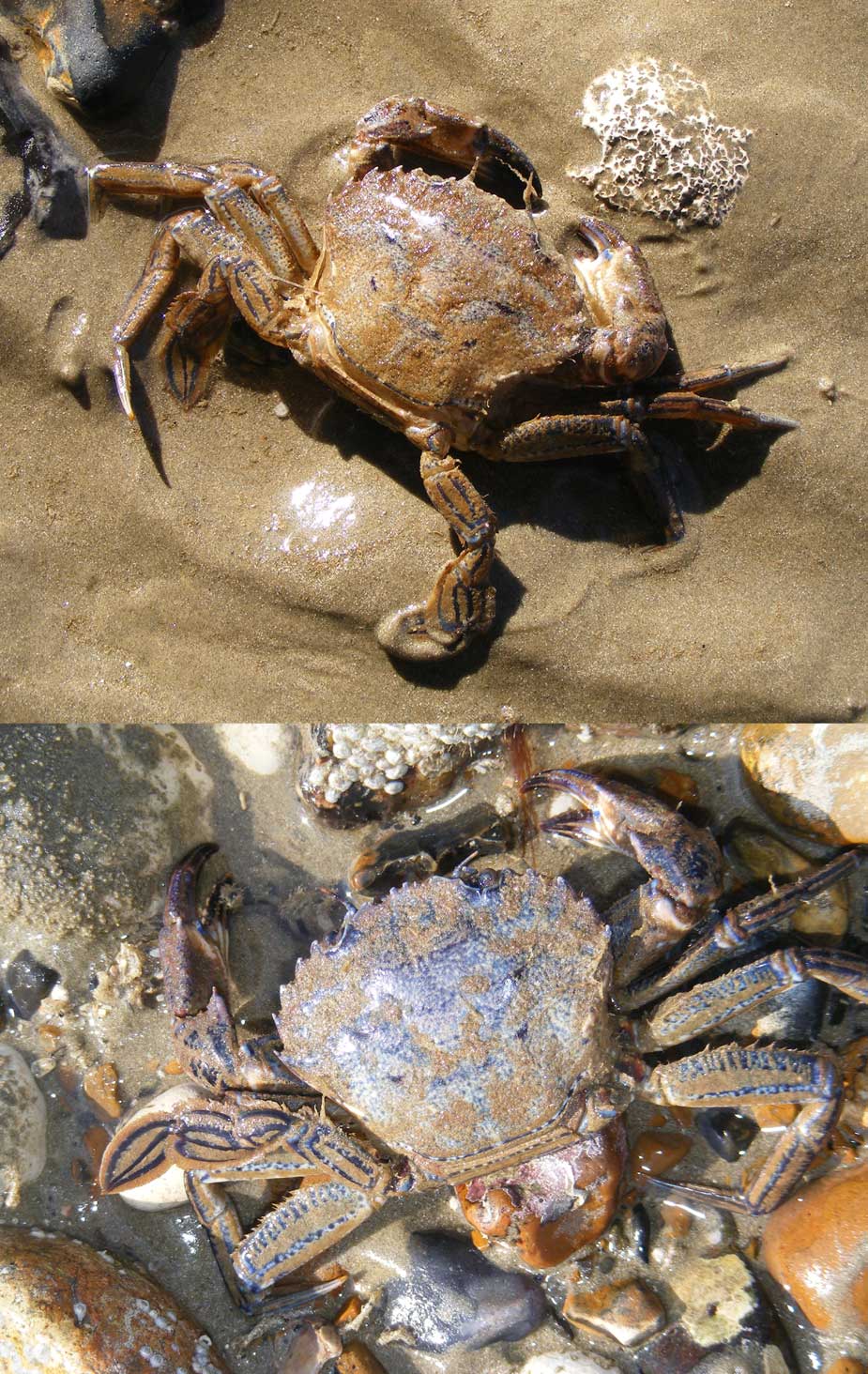 |
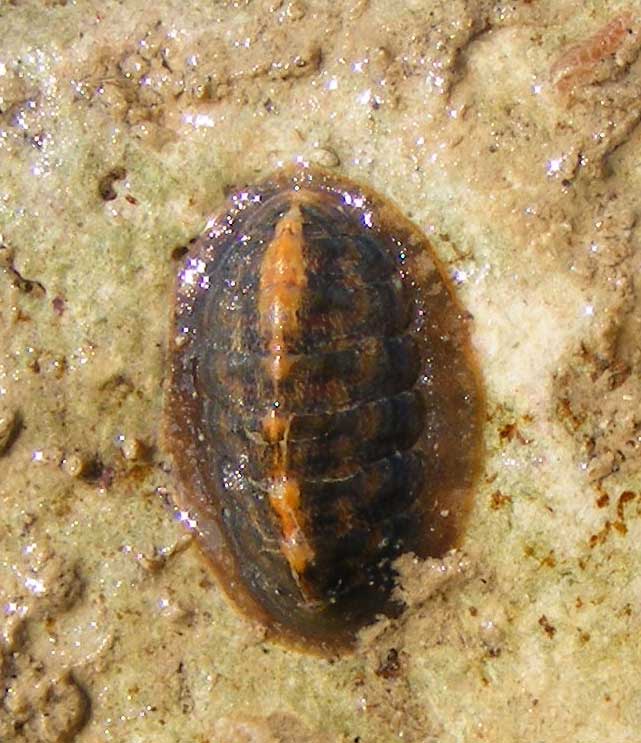 |
|
|
|
|
|
An early morning rockpooling expedition (biological collection for Adur World Oceans Day 2014) to the beach underneath Worthing Pier seemed at first to be a wasted journey because of the exiguous fauna. After about fifteen minutes the only finds were the first two, (of four), Velvet Swimming Crabs, Necora puber, and a few Shore Crabs Carcinus meanas. A small Blenny, Lipophrys pholis, was left in the pool underneath a pier support. I persevered turning rocks to the east of the pier and eventually I found small frequent Edible Crabs, Cancer pagurus, occasional small Hairy Crabs, Pilumnus hirtellus, and the inevitable tiny Long-clawed Porcelain Crabs, Pisidia longicornis, under boulders as expected. One Common Hermit Crab, Pagurus bernhardus, occupied a dogwhelk gastropod shell. Anemone fauna was almost entirely absent until a few were found as the tide receded to lap against the pier supports. Occasional sea anemones of Sagartia troglodytes, occasional Beadlet Anemones, Actinia equina, two Daisy Anemones Cereus pedunculatus, and two Snakelocks Anemones, Anemonia viridis, were recorded. The absence of the sea anemones indicated it was too early in the year for many finds on this particular beach. Molluscs were the usual mussels, limpets, Grey Topshells, dogwhelks but also a chiton and a Sting Winkle, Ocenebra erinacea. The only other fish seen was a sub-adult Butterfish, Pholis gunnellus, underneath a rock.
13 February 2014
A dead Lumpsucker, Cyclopterus lumpus, was discovered washed up on Lancing Beach.
201328 September 2013
Sean Clark caught this very young 30 cm long shark off the coast at Lancing Beach in the evening. It is a very young Starry Smooth-hound, Mustelus asterias, which was born alive (ovoviviparous) in the mother shark at a length of about 30 cm. Adults attain a length of two metres. (I could be the similar Smooth-hound, Mustelus mustelus?)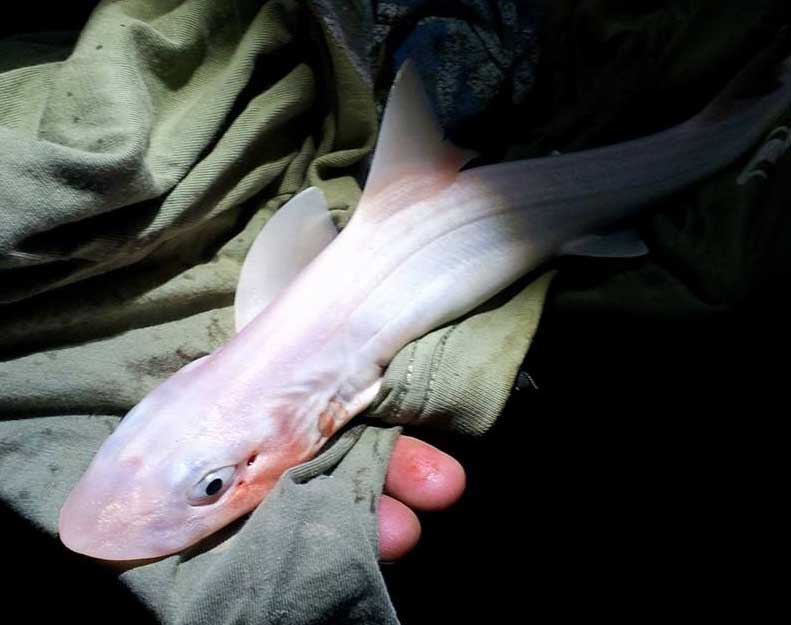
Starry Smooth-hound
Photograph by Sean Clark
| 24
July 2013
In the early evening one Bluefire Jellyfish, Cyanea lamarkii, was discovered washed up on the shore on Lancing Beach. Other specimens of this stinging jellyfish were seen in the shallow water. This jellyfish has not been recorded on the shore locally in my records and the species is usually associated off the western coasts of Britain although there have been North Sea reports. Report
& Photograph by Carol Thomson
|
 |
7
July 2013
On
the warmest day of the year (26.4 °C),
a Common Seal
was reported from Lancing Beach by Widewater.
29
May 2013
An
overcast morning was a least dry and with little or no wind, it was the
first opportunity of a shrimping
expedition with the small one metre wide net to Lancing
Beach by Widewater on the low (0.2 metres) incoming tide
from 9:11 am.
There was disappointingly little caught apart from a pint of Brown
Shrimps, Crangon crangon,
one small Common Hermit Crab,
Pagurus
bernhardus, one South-clawed
Hermit Crab,
Diogenes
pugilator, a few tiny flatfish,
but no larger flatfish
or sand crabs
for Adur World Oceans
Day 2013. A small Shore
Crabs Carcinus
meanas and one prawn
Palaemon
serratus, were incidentals together
with a dozen Slipper Limpet,
Crepidula
fornicata, clusters and a clump of
Squid
eggs.
27
May 2013
In
an early evening (8:00 pm)
visit to under Worthing Pier at a very
spring low tide, the notable discoveries included
one sub-adult 5-Bearded Rockling,
Ciliata
mustela, two tiny thread-like juvenile
Butterfish,
Pholis
gunnellus, and one slightly large one, a smallish Velvet
Swimming Crab,
Necora
puber, one Dahlia
Anemone, Urticina felina,
and the usual species of crabs
and sea anemones,
although Snakelocks
Anemones,
Anemonia
viridis, were smaller and only occasionally
spotted. The usual species included small (winkle-sized shells) Common
Hermit Crabs,
Pagurus bernhardus,
Hairy
Crabs, Pilumnus
hirtellus, two small Squat
Lobsters, Galathea
squamifera, common sea anemones of
Sagartia
troglodytes, occasional Beadlet
Anemones,
Actinia
equina, a few Daisy
Anemones
Cereus
pedunculatus, with tiny Long-clawed
Porcelain Crabs, Pisidia
longicornis,
under boulders as expected.
26
May 2013
An
Adur
World Oceans Day 2013 collection visit
to Lancing Beach was an early start at 6:30
am and I only managed the beach opposite Lancing
Beach Green (western end) to catch the incoming
spring
tide. There were not many rocks that could
be lifted and the haul was small with the only invertebrates of interest
were a small
Common Starfish Asterias
rubens, two Common
Hermit Crabs,
Pagurus bernhardus,
one in small Whelk shell and the slightly
smaller one in the smaller Dogwhelk shell,
one small Hairy Crab, Pilumnus
hirtellus, a few tiny Edible
Crabs,
Cancer
pagurus, a handful of the smaller Shore
Crabs Carcinus
meanas, and four sea anemones Sagartia
troglodytes. The most interesting discovery
were two Small-headed Clingfish,
Apletodon
dentatus, which I had not seen since 2005.
BMLSS
Rockpooling
15 July 2012
Walking from Splash Point to under Worthing Pier we saw many clumps of Cuttlefish eggs, Sepia officinalis, loads with fry inside. Then we spotted some baby Cuttlefish on the sand out of the eggs, we picked some up and put them in water pools. The surf was to strong and we know they would simply wash up again. We hope they will survive, one baby even squirted ink and was only as big as my thumb nail. Cuttlefish Culture (Bob Alexander)
 |
4 June 2012 An Adur World Oceans Day 2012 collection visit to Worthing Pier was more productive than expected although only a small haul was taken home. Most impact will be achieved with the two large Velvet Swimming Crabs, Necora puber, but I most pleased with a handful of small Common Hermit Crabs, Pagurus bernhardus, in winkle shells, a single Common Starfish Asterias rubens, one Dahlia Anemone, Urticina felina, a Brittlestar, one small Long-legged Spider Crab Macropodia rostrata, and one sub-adult 5-Bearded Rockling, Ciliata mustela. |
Velvet Swimming Crab
A Bullhead
Taurulus
bubalis., several Blennies,
Lipophrys
pholis, including a full grown adult,
and Shore Crabs Carcinus
meanas and frequent Edible
Prawns, Palaemon serratus,
were all left in-situ.
 |
 |
 |
|
|
|
|
A
Greater
Pipefish,
Syngnathus acus,
was rescued from the beak of a Herring
Gull (but this might be too badly damaged
and looked ill when I arrived home: it died over night). Small Squat
Lobsters,
Galathea
squamifera, and very small Hairy
Crabs, Pilumnus
hirtellus, were spotted under rocks.
Large (30 mm disc diameter) Daisy Anemones,
Cereus
pedunculatus, included quite a few in chocolate
brown hues. Snakelocks Anemones,
Anemonia
viridis, were common as usual with frequent
Beadlet
Anemones Actinia equina.
 |
The study shows the banded underneath of the brittlestar. It is probably the abundant species known as Common Brittlestar, Ophiothrix fragilis. It was discovered in open water with the incoming tide. When inverted this Brittlestar quickly (within 10 seconds) rights itself. |
28
May 2012
A
special shrimping
trip to Lancing Beach (by Widewater) (with
Selena Barr and Philippa Lane from Field
magazine, and Peter Talbot-Elsden)
in ideal weather conditions (1.5 metre
neap low tide) caught three pints of Brown
Shrimps, Crangon crangon,
between
us. There was not much else in the nets: frequent flatfish
fry, two small Lesser
Weever,
Echiichthys
vipera, one swimming
crab Portumnus latipes with
"fleur-de lis"
markings, one Vernal Crab, Liocarcinus
vernalis, one badly damaged (but still
alive, it nipped me) Masked Crab, Corystes
cassivelaunus, a few large green Shore
Crabs, Carcinus maenas, and
a small Plaice,
Pleuronectes
platessa, (or possibly a Flounder?).
6 May
2012
 |
 |
 |
|
|
|
|
The low equinoctial tide at Lancing receded as far as had seen it uncovering rocks that are rarely seen. It was early in the year and the intertidal fauna was exiguous: two Snakelocks Anemones, Anemonia viridis, frequent Hairy Crabs, Pilumnus hirtellus, one Short-legged Spider Crab Eurynome aspera, and one 5-Bearded Rockling, Ciliata mustela, were notable (and the first wild sea anemones, crabs and fish I had noted this year.) I also discovered a small brown Beadlet Anemone Actinia equina, just the one sea anemone Sagartia troglodytes, and one small Squat Lobster, Galathea squamifera.
Over thirty Herring Gulls fossicked amongst the rocks but it was only one Crow that tried to drop shells to break them open (without success). Three Sanderlings pattered over the sand and rock fringes.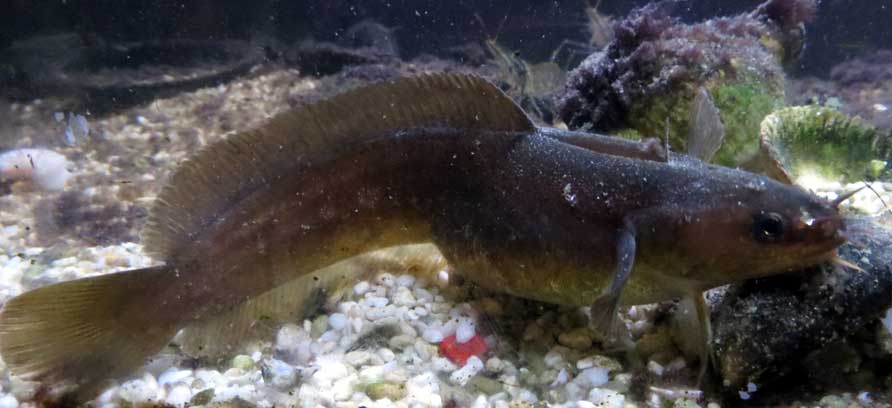
5-Bearded Rockling
NB: The Beadlet Anemone (now a strawberry type) collected last year is still alive in my marine aquarium.
2
June 2011
After
the amount of weed
washed up on the shore after the sustained period of over a week of Force
5 Breezes, it was not promising for shrimping
off Lancing Beach by Widewater with the sand just showing on 1.5 metres
low tide in the early evening. My fears were
well founded, there was too much weed
to make shrimping practical, with under ten Brown
Shrimps, Crangon crangon,
in just over half an hour push-netting. One very young Greater
Pipefish
Syngnathus acus,
fry that came with the weed and quickly wriggled to escape through the
mesh of my smaller metre-wide shrimp net. It was the first capture, followed
by two
South-clawed Hermit Crabs,
Diogenes
pugilator, in Netted
Dogwhelk shells, one small Arch-fronted
Swimming Crab Liocarcinus
arcuatus, just
one small Sand Sole, Pegusa
lascaris, and
two small flatfish fry.
To compound the poor day, I cycled to the beach on the loaded Trade's Bike
against a south-westerly Force 3,
and whilst I was shrimping
the wind turned to the north-east and rose
to Force 4 and I could see this on the sea
as the white crests on the braking waves increased in frequency. I had
to cycle back against the wind as well.
22
May 2011
A
steady Force 6
westerly Strong Breeze (26 mph), gusting to Gale Force 7,
was kite-surfing weather and because the low tide
was 1.1 metres the most easterly exposed shore was south of Brooklands.
The pools were rippled by the wind and there were few rocks to turn and
an even poorer fauna: a few Snakelocks
Anemones,
Anemonia
viridis, just three Hairy
Crabs, Pilumnus
hirtellus, a small stripy green Beadlet
Anemone, Actinia equina,
one dark Edible Crab,
Cancer
pagurus, a Shore
Crab Carcinus
meanas and a small Squat
Lobster, Galathea
squamifera. The shore was strewn with
small empty mussel shells.
19
May 2011
A
large plain green specimen of the Beadlet
Anemone, Actinia equina,
collected on Worthing Beach
on 18 April 2011 suddenly
diminished in a manner seen before in the Actinia
sea
anemones. The green specimen with a basal diameter of approximately
60 mm and a larger tentacle span shrivelled up into a smaller version that
looked as though it might be dying, and the tentacles became thinner than
those of the Snakelocks Anemones, Anemonia
viridis, and the oral disc disappeared
from view covered by the partially retracted tentacles. On 20
May 2011, I noted that sea anemone had returned
to its normal appearance. On 21 May 2011 I
noticed that its column was covered in spots which were pronounced enough
to be nearer in appearance to the designated species Actinia
fragacea. Its spots were distinct
light green but the background colour of the column became brown rather
than red. It was slightly smaller with a basal diameter of about 50 mm.
Intermediate forms or Actinia equina
with
green lines and spots are known to occur occasionally. This anemone has
green
tentacles
whereas the usual "strawberry type" has crimson
or red tentacles.
Actinia
fragacea has
strawberry-like (usually green on a red column) spots all over the column
of the anemone. The similar species Actinia
equina
can have green stripes and dotted lines, so there can be confusion between
the species as the dividing line is not clearly demarked by appearance.
BMLSS
Sea Anemones
23
April 2011
There
were almost ideal condition for shrimping
of Lancing Beach (east Widewater) with a gentle almost imperceptible swell,
almost negligible Light Breeze Force
5, (5 mph,
NNE), pleasant weather
with an air temperature of 18.9 °C
on the 9.50 am
low tide of 1.1 metres. Brown
Shrimps, Crangon crangon,
were
common (200+ caught in 40 minutes), although some were too small for the
pot. The water was clear and free of weed, but there was very little else
around. I caught two young Plaice,
Pleuronectes
platessa, one of which escaped and
a handful shot off at the approach of the smaller (one metre) semi-circular
shrimp net, and the only other incidentals were three very small Common
Hermit Crabs, Pagurus bernhardus,
(i.e. not Diogenes)
in Grey Topshells and Netted
Dogwhelk shells.
Advection
fog set in over the sea as the tide
turned and the visibility was diminished to under 50 metres.
Met
Office: Shoreham
Both Grey Sea Slugs, Aeolidia papillosa, laid their white coils of spawn in two separate aquaria.
18
April 2011
The
low tide around Worthing
Pier was very rich in multi-coloured seaweeds
especially the alien Sargasso Weed
and pink clumps which I first thought were Corallina,
but now I am not so sure. They might be Jania
rubens (to
be confirmed) which is a coralline
algae. I disturbed three Turnstones
feeding at the water's edge at the end of the pier. They squawked and flew
away.
 |
 |
 |
However,
the fauna was poor and there were not many rocks to turn over. Of most
note were the frequent Snakelocks
Anemones,
Anemonia
viridis, and two clumps of fish eggs* possibly
of the Bullhead Taurulus
bubalis. Two anemone-eating
nudibranchs
Grey Sea Slugs, Aeolidia
papillosa, were discovered under rocks
under the pier. Occasional Squat
Lobsters,
Galathea
squamifera, just three Hairy
Crabs, Pilumnus
hirtellus, frequent tiny Long-clawed
Porcelain Crabs, Pisidia
longicornis,
a handful of undersized Edible Crabs,
Cancer
pagurus, a few large green Shore
Crabs Carcinus
meanas and frequent Edible
Prawns, Palaemon serratus,
completed the crustacean list.
 |
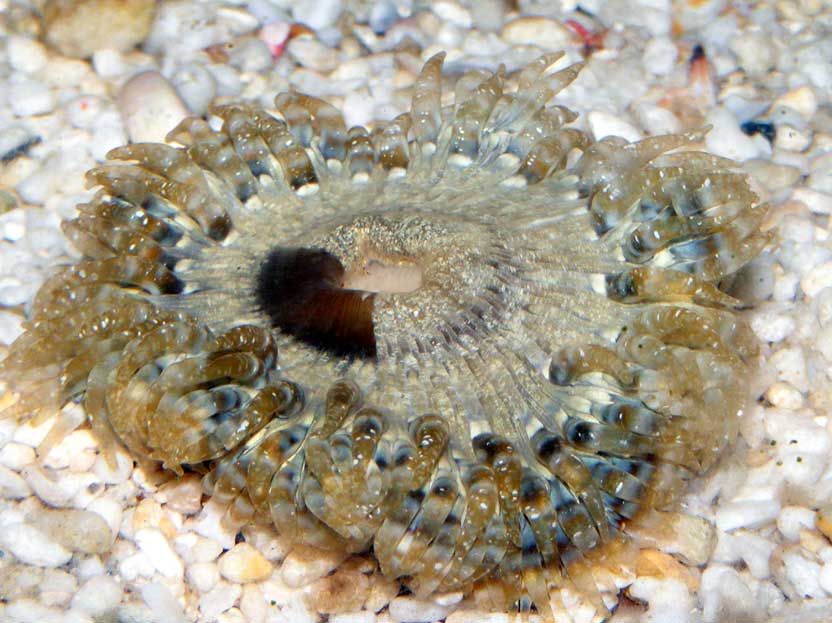 |
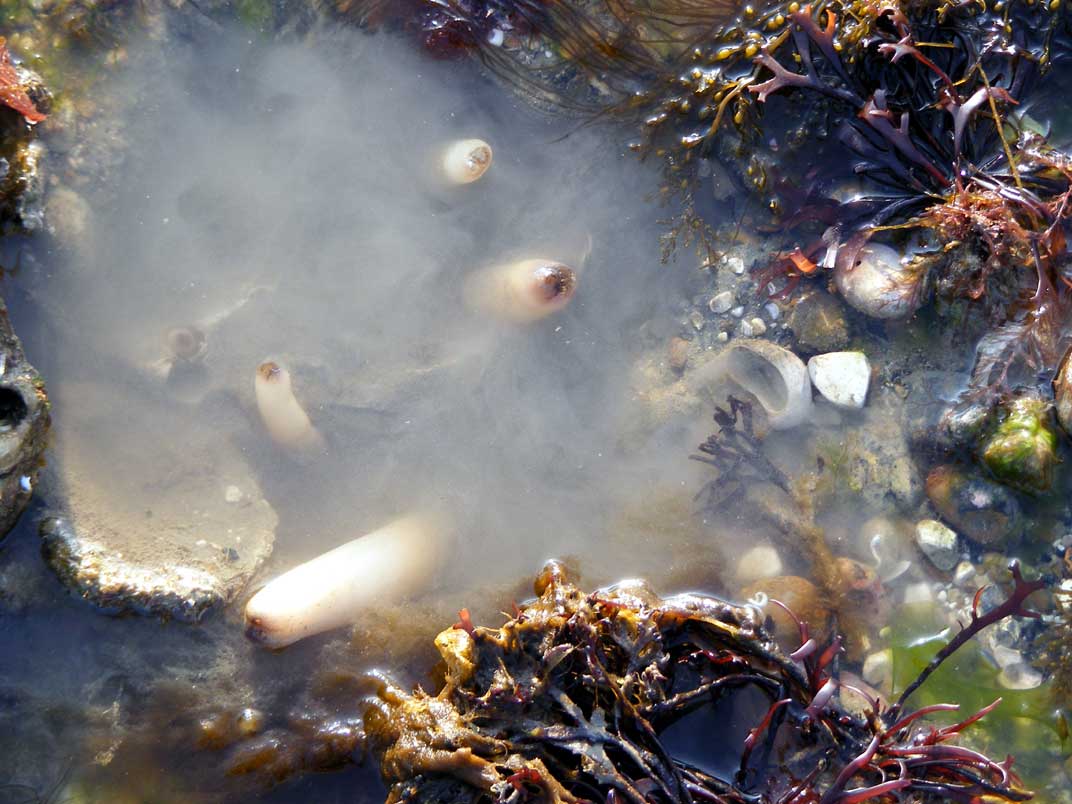 |
|
Beadlet Anemone |
|
|
Four
of the largest
Piddocks,
Pholas
dactylus, I have ever seen were underneath
a rock that had already been broken in half. Two juvenile Long-spined
Bullheads, Taurulus
bubalis, and one first year Blenny,
Lipophrys
pholis, were netted. Beadlet
Anemones
were frequently seen, with a few sea anemones Sagartia
troglodytes, and a few Daisy
Anemones, Cereus pedunculatus.
(*
The eggs hatched out in the home aquarium. They
could very well be Blenny eggs.)
 20
March 2011
20
March 2011
In
the early evening, I recorded by first wild fish of the year a 5-Bearded
Rockling, Ciliata mustela,
on the kelp-covered shore by Brooklands (west Lancing, west of the pipeline)
plus my first crab, a very small Velvet
Swimming Crab,
Necora
puber. The
shore was very poorly inhabited with frequent Squat
Lobsters,
Galathea
squamifera, occasional small Hairy
Crabs, Pilumnus
hirtellus, and tiny Long-clawed
Porcelain Crabs, Pisidia
longicornis,
one very small Edible Crab,
Cancer
pagurus, one large green Shore
Crab Carcinus
meanas. Two Snakelocks
Anemones,
Anemonia
viridis, had not quite completed their division
into two, and there were occasional small sea anemones
Sagartia
troglodytes.
As it was getting too dark to see clearly, a tiny thread-like juvenile
Butterfish,
Pholis
gunnellus, eluded my cold fingers. An Edible
Prawn, Palaemon serratus,
jumped backwards from under a weed-covered rock.
 |
October
2010
These two Sand Smelt, Atherina presbyter, were caught off Worthing Pier. Report
and Photograph by John Nalaskowski
|
25
May 2010
I
made an unplanned visit to Worthing Pier as the tide
was out. Under the many small rocks, there were two adult Blennies,
Lipophrys
pholis,
and a few undersized Edible
Crabs, Cancer pagurus.
The most notable discovery on the underside of a rock was a tiny nudibranch
sea slug Facelina
auriculata. Its cerata and overall
appearance were bright crimson.
21
May 2010
My
first shrimping outing of the year using my smaller three foot wide shrimp
net on the medium tide on Lancing Beach (Widewater
West) yielded a rather poor 30 or so Brown
Shrimps,
Crangon crangon,
but not enough exhibits for
Adur World Oceans Day
2010: a left-eyed flatfish*
that was too large for the aquarium, only a very small Sand
Sole, Pegusa lascaris,
two
South-clawed Hermit Crabs,
Diogenes
pugilator, one very small Vernal
Crabs, Liocarcinus
vernalis, and an even smaller tiny
swimming
crab Portumnus latipes was the
total catch in an hour on a tide that had not receded enough.
| *The flatfish was identified as a Turbot, Psetta maxima, measuring 180 mm (excluding the caudal fin) long and 80 mm wide (excluding fins) and weighing about 125 grams. |  |
 29
May 2009
29
May 2009
Shrimping
was possible after some poor weather. And the conditions were ideal off
Lancing Beach (near the Church of the Good Shepherd) but the haul of Brown
Shrimps, Crangon crangon,
amount to about thirty all after the tide turned
and with the incoming tide. Luckily (because the expedition was to get
exhibits for Adur World Oceans Day 2009) the
haul with my smaller U-shaped net including two medium-sized Lesser
Weevers,
Echiichthys
vipera, amongst the weed so I had
to be careful of the venomous fins,
two adult Sand Sole, Pegusa
lascaris,
one intact Vernal Crab Liocarcinus
vernalis, half a dozen flatfish
(probably
Plaice) fry, one small Plaice,
two
South-clawed
Hermit Crabs,
Diogenes pugilator,
one
swimming crab Portumnus latipes,
and a very young Greater Pipefish Syngnathus
acus. A Painted
Lady Butterfly fluttered around my head.
24
May 2009
A
rockpooling
trip to the rocky shore by the Half Brick, east Worthing was a serious
disappointment with hardly anything of interest. It took at least 30 minutes
to find a Velvet Swimming Crab Necora
puber, three Shore Crabs Carcinus
maenas, a very small Common
Squat Lobster, two Snakelocks
Anemones Anemonia
viridis, a large one-clawed Edible Crab
Cancer
pagurus, a Prawns
Palaeamon
serratus, one very small
Common Hermit
Crab,
Pagurus
bernhardus, a few Sagartia
troglodytes sea anemones and two Daisy
Anemones Cereus
pedunculatus. It was ten minutes before I
spotted a Chiton
(a mollusc in the class Polyplacophora)
probably Lepidochitona
cinerea.
There
were a few elusive (evaded capture) adult Common
Gobies,
Pomatoschistus
microps, in breeding livery with fry
is the shallow sandy pools. In a deeper pool, a solitary Sand
Smelt, Atherina
presbyter, cruised
by.
23
May 2009
Shoreham
Beach (especially over the border in Lancing to the west of the Church
of Good Shepherd) was covered in swathes of flowering
Red Valerian and Sea
Kale and Viper's
Bugloss was in flower (first time noted
this year although flowering must have occurred for at least a week) plus
the first Slender Thistle in
flower this year.
On
Widewater a pair of Mute Swans
had a handful (I did not count them) of cygnets.
The
early evening shrimping expedition at Lancing
was exceptionally poor registering just half a dozen Brown
Shrimps, Crangon crangon,
with most of them too small and one large one escaped through the net meshing.
Incidental captures were exiguous: three very young Greater
Pipefish Syngnathus acus,
three*
Sand
Sole, Pegusa lascaris,
two one-clawed Vernal Crabs Liocarcinus
vernalis, half a dozen flatfish
(probably
Plaice) fry, one South-clawed
Hermit Crab,
Diogenes pugilator,
and a Lesser Spotted Dogfish Scyliorhinus
canicula purse
with an embryo.
There was a much darker brown different pipefish that escaped the net.
This could have been either a juvenile Worm Pipefish Nerophis
lumbriciformis, or even a juvenile
Snake
Pipefish Entelurus aequoreus. A
clump of the black grape-like Cuttlefish
eggs were discovered washed up on
the strandline.
(*One
was damaged and released and another one swam out of the net.)
3 June
2008
Cycling
past Lancing Beach Green, I must have seen at least 70
Crows
on the grass and beach huts and possibly more.
 |
 |
 |
 |
Plants in flower noted for the first time this year on Lancing Beach shingle and surrounds included Viper's Bugloss, Opium Poppy, Yellow-horned Poppy, Silver Ragwort and Slender Thistle. The seed heads of Goat's Beard were very noticeable on the borders of the shingle and cyclepath. And Tree Mallow by a gate marked Lancing Point to the west of Lancing Sailing Club. The sole butterfly seen on the day was a Large White in the same area as the Tree Mallow.
22
May 2008
 |
 |
 |
|
and Scarlet Pimpernel |
|
|
Flowers of Lancing Beach
7
May 2008
The
shore with rocks uncovered on the low spring tide
by the Half Brick, east Worthing, was ordinary with the usual fare of with
common (100+) SnakelocksAnemones,
Anemonia
viridis,
common and some large Daisy
Anemones
Cereus
pedunculatus,
frequent sea anemones Sagartia
troglodytes,
a few Edible
Crabs Cancer pagurus,
frequent Hairy Crabs Pilumnus
hirtellus, common Long-clawed
Porcelain Crab Pisidia longicornis
and a few small Shore Crabs
Carcinus
maenas and a few
Prawns
Palaeamon
serratus, a few very small
Common Hermit
Crabs,
Pagurus
bernhardus in Grey
Topshells, and a few of the tiny shrimp Athanas
nitescens in red livery. One
healthy Butterfish,
Pholis
gunnellus, was discovered hiding under a rock. The only
thing vaguely unusual was the first nudibranch
sea slug, a small Acanthodoris
pilosa in a fawn colour and larger
than normal. I had not seen one for several years.
BMLSS
Hermit Crabs
BMLSS
Nudibranchs
5 May
2008
On
Bank
Holiday Monday, it felt warm for the first
time this year as the temperature reached 20.0
°C at midday.
The wind veered around to the south-east by the afternoon.
Shoreham
Weather
My
first shrimping expedition
of the year at Lancing produced a moderate amount of Brown
Shrimps, Crangon crangon, plus
one Lesser Weever,
Echiichthys
vipera, one small Sand
Sole, Pegusa lascaris,
two
Vernal Crabs, Liocarcinus
vernalis, and two South-clawed
Hermit Crabs,
Diogenes pugilator,
(in
Netted Dogwhelk shells) amongst more weed
than is usual at the beginning of May.
Sussex
Marine Life
4 February
2008
 |
 |
After the recent storm there was a mass stranding on Lancing Beach east at low tide. I braved the chill westerly breeze and found the usual 'Mermaid's Purses' Dogfish Egg cases (including three with embryos seen inside), Ray Egg cases, orange and white sponges, Whelk shells and egg cases Buccinum, and also hundreds of dead sea anemones, including dead and alive Snakelocks Anemones, Anemonia viridis. and larger Dahlia Anemones, Urticina felina.
In
the second photograph on Worthing Beach, the clear up of the wood continues.
21 January 2008
Timber
on Worthing Beach
Photograph
by Viv Lonsdale
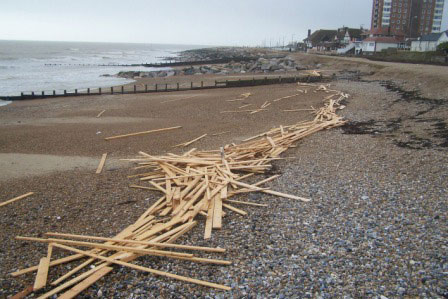 |
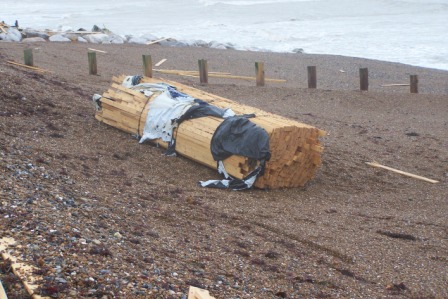 |
Timber from Greek registered Ice Prince, which sank about 26 miles (42 km) off Dorset after a storm on 15 January 2008, began getting washed up on Lancing beach in the evening of 19 January 2008 and tonnes of pine planks littered the local beaches from 20 January 2008.
Marine
Life of Sussex 2006
Link
to Lancing Beach 2004 Reports
Half
Brick Beach 2004
Link
to Lancing Beach 2003
Lancing Beach (by Ray Hamblett)
EMail
Address for sending in wildlife reports from the lower Adur valley
Only
a selection will be included and only reports with the name of the reporter
|
|
|
|
|
News 2018 |
Membership Form |
|
|
|
|
|
|
|